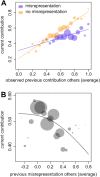Misrepresentation of group contributions undermines conditional cooperation in a human decision making experiment
- PMID: 35853937
- PMCID: PMC9296641
- DOI: 10.1038/s41598-022-16613-5
Misrepresentation of group contributions undermines conditional cooperation in a human decision making experiment
Abstract
Cooperative behaviour can evolve through conditional strategies that direct cooperation towards interaction partners who have themselves been cooperative in the past. Such strategies are common in human cooperation, but they can be vulnerable to manipulation: individuals may try to exaggerate their past cooperation to elicit reciprocal contributions or improve their reputation for future gains. Little is known about the prevalence and the ramifications of misrepresentation in human cooperation, neither in general nor about its cultural facets (self-sacrifice for the group is valued differently across cultures). Here, we present a large-scale interactive decision making experiment (N = 870), performed in China and the USA, in which individuals had repeated cooperative interactions in groups. Our results show that (1) most individuals from both cultures overstate their contributions to the group if given the opportunity, (2) misrepresentation of cooperation is detrimental to cooperation in future interactions, and (3) the possibility to build up a personal reputation amplifies the effects of misrepresentation on cooperation in China, but not in the USA. Our results suggest that misrepresentation of cooperation is likely to be an important factor in (the evolution of) human social behaviour, with, depending on culture, diverging impacts on cooperation outcomes.
© 2022. The Author(s).
Conflict of interest statement
The authors declare no competing interests.
Figures




References
-
- Perc M, Jordan JJ, Rand DG, Wang Z, Boccaletti S, Szolnoki A. Statistical physics of human cooperation. Phys. Rep. 2017;687:1–51. doi: 10.1016/j.physrep.2017.05.004. - DOI
-
- Trivers RL. The evolution of reciprocal altruism. Q. Rev. Biol. 1971;46:35–57. doi: 10.1086/406755. - DOI
-
- Nowak MA, Sigmund K. Tit for tat in heterogeneous populations. Nature. 1992;355:250–253. doi: 10.1038/355250a0. - DOI
Publication types
MeSH terms
LinkOut - more resources
Full Text Sources
Miscellaneous

